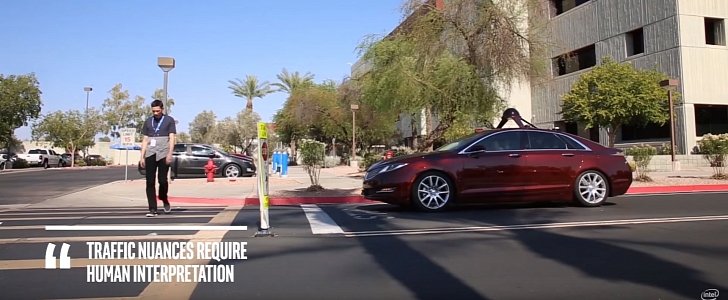The percentage of people who are still reluctant to get into a self-driving car is still very high, but that shouldn't surprise anybody. Even you may think you'd be ready, but when the time comes to fasten yourself in the backseat of a driverless car, you might have second thoughts.
I remember the first time I did it - it was at the Bosch Technology Days in Germany five to six years ago. We were jumping from car to car, each with different new fringe technologies. One would avoid a pedestrian on its own, another would brake and accelerate on its own leaving you to deal strictly with the steering.
I then climbed into a BMW 3 Series Touring with a weird thing on its roof, having no idea what to expect. And then the man behind the wheel put his hands on his lap and turned to me, smiling: "the car is driving on itself," he declared.
However, under different circumstances than the one I was in, not telling the passenger what they're getting themselves into is a sure way to end up with a lawsuit on your hands. Still, there's a theory which says that exposing somebody to what it is that causes them anxiety is one way of curing it.
Intel wanted to see if that applies to autonomous cars as well, so it gathered a small group of ten people who don't like the idea and offered them a ride. The company monitored their reactions and after it was all over, debriefed them on the experience.
First things first: all participants said their perception on self-driving cars had changed and while they wouldn't be ready to give up driving, they'd have no problem with the technology being used for ride-hailing services.
However, the ten also provided a list of very interesting insights, some of which might not have been anticipated by the developers. For instance, they said seeing the steering wheel turn by itself was disturbing, and they would much more prefer it if it were removed altogether.
They also said that once they started trusting the system, they found all the information displayed on what the car was doing distracting. Finally, another key factor highlighted by the study was that there needs to be a way to control the vehicle, preferably through verbal communication. So if you want it to slow down, for instance, you could do it in the same way you would with a human driver.
Intel is aware of the very tiny scale of its research, but it says it looks forward to expanding it for more relevant findings. Developing the technology necessary to have cars navigate by themselves is one thing, but finding a way to implement it so that people feel at ease using it is just as important.
I then climbed into a BMW 3 Series Touring with a weird thing on its roof, having no idea what to expect. And then the man behind the wheel put his hands on his lap and turned to me, smiling: "the car is driving on itself," he declared.
However, under different circumstances than the one I was in, not telling the passenger what they're getting themselves into is a sure way to end up with a lawsuit on your hands. Still, there's a theory which says that exposing somebody to what it is that causes them anxiety is one way of curing it.
Intel wanted to see if that applies to autonomous cars as well, so it gathered a small group of ten people who don't like the idea and offered them a ride. The company monitored their reactions and after it was all over, debriefed them on the experience.
First things first: all participants said their perception on self-driving cars had changed and while they wouldn't be ready to give up driving, they'd have no problem with the technology being used for ride-hailing services.
However, the ten also provided a list of very interesting insights, some of which might not have been anticipated by the developers. For instance, they said seeing the steering wheel turn by itself was disturbing, and they would much more prefer it if it were removed altogether.
They also said that once they started trusting the system, they found all the information displayed on what the car was doing distracting. Finally, another key factor highlighted by the study was that there needs to be a way to control the vehicle, preferably through verbal communication. So if you want it to slow down, for instance, you could do it in the same way you would with a human driver.
Intel is aware of the very tiny scale of its research, but it says it looks forward to expanding it for more relevant findings. Developing the technology necessary to have cars navigate by themselves is one thing, but finding a way to implement it so that people feel at ease using it is just as important.






